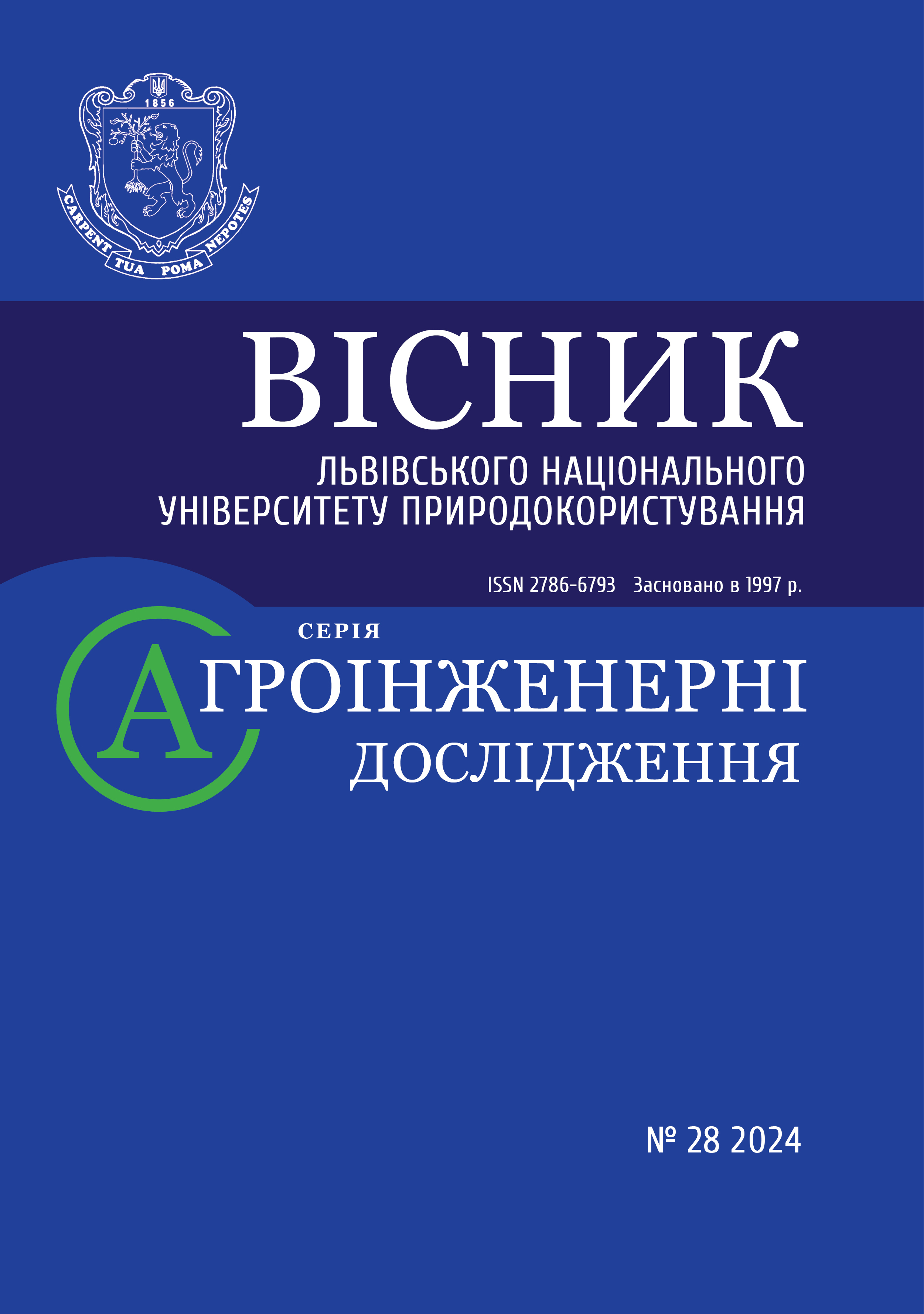Дослідження відхилення напруги від номінального значення у системі електропостачання підприємства
DOI:
https://doi.org/10.31734/agroengineering2024.28.101Ключові слова:
електропостачання, модель, напруга, гранично допустиме значення відхилення напругиАнотація
Під якістю електроенергії розуміють ступінь відповідності фактичних значень параметрів електроенергії значенням, зазначеним у ГОСТ 13109-97. У нашому дослідженні йдеться про відхилення напруги, нормальні значення яких становлять +5 або -5 %, а граничні – +10 або -10 % за ГОСТ 13109-97. Коливання напруги в мережі залежать від потужності джерела живлення, потужності, що втрачається під час електропередачі, та потужності електрообладнання. Найпоширенішими споживачами електроенергії є асинхронні двигуни, потужність яких пропорційна квадрату напруги, тому втрати значно більші. При втраті напруги швидкість обертання двигуна також зменшується, що спричиняє збільшення ковзання. Струм також збільшується, ефективність знижується, а ізоляція зношується швидше. При зниженні напруги пусковий момент двигуна і механічні характеристики погіршуються.
В електрообладнанні втрати напруги призводять до зниження потужності, збільшення витрат часу на технічні та виробничі процеси, а отже, до погіршення продуктивності та якості продукції. У разі зниження напруги освітлення також погіршується, оскільки світловий потік залежить від значення напруги. З підвищенням напруги ККД лампи зростає, але термін її служби зменшується.
Наше дослідження присвячене актуальним питанням експлуатації електромережі підприємства. Сучасні дослідницькі та аналітичні методи дали змогу досягти чудових результатів у різних сферах. Зокрема, програмне забезпечення MATLAB/Simulink дозволяє аналізувати різні параметри роботи електромереж у різних режимах, для розрахованого електропостачання підприємства побудувати модель системи електропостачання і на ній дослідити відхилення напруги від номінального значення.
У статті представлено побудовану модель розрахованої системи електропостачання підприємства у середовищі MATLAB/Simulink. Проведено дослідження роботи системи електропостачання на цій моделі. Моделювання проведено при зміні навантаження в межах від 0,2Sн до 1,2Sн. Дослідження проведено на предмет відхилення напруги в різних точках схеми від номінального значення, для трьох випадків, при зміні коефіцієнта трансформації на трансформаторі 10/0,4 кВ, для значень 400 В, 400•1,025 В, 400•1,05 В.
Аналіз отриманих результатів показав, що схема спроєктована на належному рівні, оскільки здебільшого відхилення перебувають у межах гранично допустимої норми, проте для забезпечення точнішого дотримання рівня напруги можна здійснити регулювання напруги на трансформаторі за допомогою перемикання обмотки або у першій лінії збільшити переріз проводу живлення.
Посилання
Chaban, A. V., Levoniuk, V. R., Drobot, I. M., & Herman, A. F. (2016). Matematychne modeliuvannia perekhidnykh protsesiv u linii Lekhera v stani nerobochoho khodu. Elektrotekhnika i elektromekhanika, 3, 30-35.
Chaban, A., & Levoniuk, V. (2017). Analiz neustalenykh elektromahnitnykh protsesiv u frahmenti elektroenerhetychnoi systemy na osnovi klasychnykh pidkhodiv do modeliuvannia. Visnyk Lvivskoho natsionalnoho ahrarnoho universytetu: Ahroinzhenerni doslidzhennia, 21, 167-177.
Chaban, A., Fediv, Ye, Sivakova, O., & Drobot, I. (2022). Stabilizatsiia napruhy vuzla elektrychnoho navantazhennia za dopomohoiu dvooperatsiinykh tyrystoriv. Visnyk Lvivskoho natsionalnoho universytetu pryrodokorystuvannia: Ahroinzhenerni doslidzhennia, 26, 101-108.
Chaban, A., Lis, M., Szafraniec, A., & Levoniuk, V. (2022). An application of the Hamilton-Ostrogradsky principle to the modeling of an asymmetrically loaded three-phase power line. Energies, 15(21), 8255-8273. doi: 10.3390/en15218255.
Chaban, A., Lis, M., Szafraniec, A., & Levoniuk, V. (2022). Mathematical Modelling of Transient Processes in a Three Phase Electric Power System for a Single Phase Short-Circuit. Energies, 15(3), 1126-1143. doi: 10.3390/en15031126.
Chaban, A., Perzyński, T., Popenda, A., Figura, R., & Levoniuk, V. (2022). Mathematical Modeling of Transient Processes in the Susceptible Motion Transmission in a Ship Propulsion System Con-taining a Shaft Synchro-nous Generator. Energies, 15(9), 3266-3274.
Chaban, A., Popenda, A., Szafraniec, A., & Levoniuk, V. (2023). Including shield wires in the analysis of transient processes occurring in HVAC transmission lines. Energies, 16(23), 7870-7889. doi: 10.3390/en16237870.
Durniak, B. V., Chumakevych, V. O., Liakh, I. M., Yatsun, A. M. (2017). Osnovy elektropostachannia ahropromyslovoho kompleksu: Navch. posib. Lviv: Ukrainska akademiia drukarstva.
Halanov, V. P., & Halanov, V. V. (2001). Vlyianye kachestva elektroэnerhyy na uroven ee poter v setiakh. Elektrycheskye stantsyy, 63.
Hoholiuk, O. P. (2010). Doslidzhennia elektroperedachi v suchasnykh kompiuternykh seredovyshchakh. Visnyk Natsionalnoho universytetu “Lvivska politekhnika”, 671, 24-31.
Hrechyn, D., & Drobot, I. (2023). Doslidzhennia vidkhylen napruhy u merezhi elektropostachannia pidpryiemstva pry ekspluatatsii elektroobladnannia. Visnyk Lvivskoho natsionalnoho universytetu pryrodokorystuvannia: ahroinzhenerni doslidzhennia, 27, 61-69.
Levoniuk, V. (2016). Porivnialnyi analiz matematychnykh modelei perekhidnykh elektromahnitnykh protsesiv v elementakh elektroenerhetychnykh system. Visnyk Lvivskoho natsionalnoho ahrarnoho universytetu: Ahroinzhenerni doslidzhennia, 20, 155-161.
Liakh, V. V., Molchanov, V. M., Sudakova, Y. V., & Pavlychenko, Y. V. (2009). Kabelnaia linyia napriazheniem 330 kV – novyi etap razvytyia elektrycheskykh setei Ukrayny. Elektrycheskye sety y systemy, 3, 16-21.
Perzynski, T., Levoniuk, V., & Figura, R. (2023). Transient Electromagnetic Processes Analysis in High Voltage Transmission Lines during Two-Phase Short Circuits. Sensors, 1, 298. doi: 10.3390/s23010298.
Shcherba, A. A, & Lobodzynskyi, V. Iu. (2011). Matematicheskae modelirovanie elektromahnitnykh protsessov v trekhfaznoi kabelnoi lynyy elektroperedachy pry raznykh transpozitsiiakh ekranov odnofaznykh kabelei. Tekhnichna elektrodynamika. Tem. vyp. "Sylova elektronika ta enerhoefektyvnist", 2, 271-276.
Shesterenko, V. Ie. (2004). Systemy elektrospozhyvannia ta elektropostachannia promyslovykh pidpryiemstv: Pidruchnyk. Vinnytsia: Nova kn.
Vorotnytskyi, V. E., Zahorskyi, Ya. T., & Apriatkyn, V. N (2000). Raschet, normirovanie y snizhenie poter elektroenerhii v elektricheskikh setiakh. Elektricheskye stantsii, 5, 154.
Zolotarev, M. V., & Oboznyi, A. L. (2006). Novie otechestvennie razrabotki v oblasti silovykh kabelei. Visnyk NTU KhPI, 34, 129-132.
Zolotarev, V. V., Karpushenko, V. P., Naumenko, A. A., & Buzko, S. V. (2006). Matematycheskaia model elektricheskoi napriazhennosty izolirovannykh zhil silovykh kabelei. Fyzycheskye i kompiuternye tekhnolohii: Trudy 12 Mezhdunar. nauch.-tekhn. konf. (pp. 239-240). Kharkov: KhNPK “FED”.


